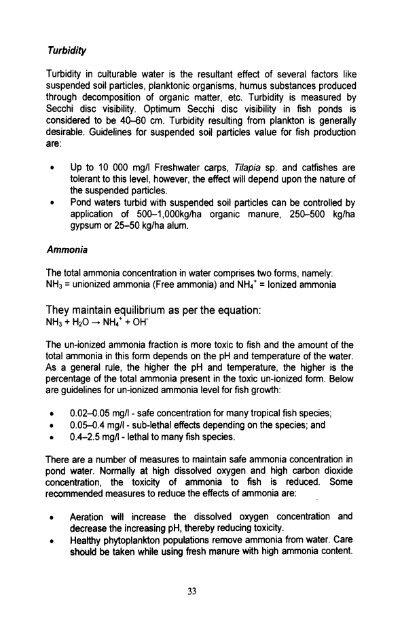Director Ambekar E. Eknath, Ph. D Head, APED J.K. Jena, Ph. D ...
Director Ambekar E. Eknath, Ph. D Head, APED J.K. Jena, Ph. D ...
Director Ambekar E. Eknath, Ph. D Head, APED J.K. Jena, Ph. D ...
You also want an ePaper? Increase the reach of your titles
YUMPU automatically turns print PDFs into web optimized ePapers that Google loves.
Turbidity<br />
Turbidity in culturable water is the resultant effect of several factors like<br />
suspended soil particles, planktonic organisms, humus substances produced<br />
through decomposition of organic matter, etc. Turbidity is measured by<br />
Secchi disc visibility. Optimum Secchi disc visibility in fish ponds IS<br />
considered to be 40-60 cm. Turbidity resulting from plankton is generally<br />
desirable. Guidelines for suspended soil particles value for fish production<br />
are:<br />
Ammonia<br />
Up to 10 000 mgll Freshwater carps, Tilapia sp. and catfishes are<br />
tolerant to this level, however, the effect will depend upon the nature of<br />
the suspended particles.<br />
Pond waters turbid wlth suspended soil particles can be controlled by<br />
application of 500-1,000kglha organic manure. 250-500 kglha<br />
gypsum or 25-50 kglha alum.<br />
The total ammonia concentration in water comprises two forms, namely:<br />
NH3 = unionized ammonia (Free ammonia) and NH4' = Ionized ammonia<br />
They maintain equilibrium as per the equation:<br />
NH, + H20 -+ NH4' + OH'<br />
The un-ionized ammonia fraction IS more toxic to fish and the amount of the<br />
total ammonia in this form depends on the pH and temperature of the water.<br />
As a general rule, the higher the pH and temperature, the higher is the<br />
percentage of the total ammonia present in the toxic un-ionized form Below<br />
are guidelines for un-ionized ammonia level for fish growth:<br />
0.02-0.05 mgll -safe concentration for many tropical fish species;<br />
0.05-0.4 mgll - sub-lethal effects depending on the species; and<br />
0.4-2.5 mgll - lethal to many fish species.<br />
There are a number of measures to maintain safe ammonia concentration in<br />
pond water. Normally at high dissolved oxygen and high carbon dioxide<br />
concentration, the toxicity of ammonia to fish is reduced. Some<br />
recommended measures to reduce the effects of ammonia are:<br />
Aeration will increase the dissolved oxygen concentration and<br />
decrease the increasing pH, thereby reducing toxicity.<br />
Healthy phytoplankton populations remove ammonia from water. Care<br />
should be taken while using fresh manure with high ammonia content.

















